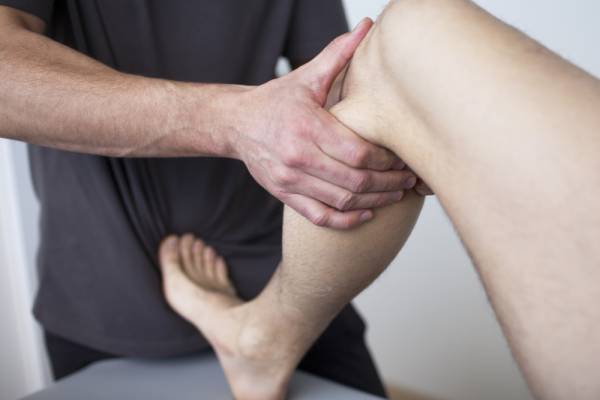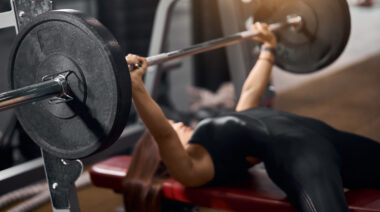EDITOR’S NOTE: The following relates the personal experience of a Pulse Beat Fit contributor, Cara Kobernik, and does not represent an endorsement of ART or of Dr. Brian Gervais by Pulse Beat Fit. No compensation of any kind was accepted or given by any party in exchange for this article.
Dr. Brian Gervais isn’t your typical chiropractor. While chiropractic care can be hugely important to maintain spine health, Active Release Techniques (ART) focuses on injured areas to increase mobility and strength when training hurts and ongoing injuries occur.
Dr. Gervais searching for problematic areas of tension with his client
<strong”>Dr. Gervais uses ART on a daily basis with his patients and has seen an enormous amount of people benefit from this unique and effective technique.
Athletes, ART Is for You
Do you ever feel stuck with an ongoing injury or have a muscle-related pain you just can’t get past? Many of us have been there, or are currently there, dealing with a bound-up spot. It’s a frantic feeling, wondering if our training should cease or if we should take an extended rest due to said injury.
ART may be a solution to this type of physical and mental agony and Dr. Gervais has helped many athletes get past injury with this technique, so he would know. He is an ART assistant instructor and holds a Chiropractic Sports Physician Certification from Western States Chiropractic College.
“Because ART is a movement based technique additional mobility exercises help maximize the benefit of the treatment.”
When I spoke with Dr. Gervais, he described the methodology behind ART as a way to treat scar tissue and adhesions that crop up as a result of using, and sometimes overusing, muscles. These adhesions and scar tissue areas then put tension on tendons, fascia, ligaments, and nerves. This is bad news for any sort of recovery.
Because ART is based on movement, it has the potential to advance an athlete past an injury in a non-invasive way. The ART provider identifies the problematic area through palpation and having the athlete recreate the painful movement until the source of the scar tissue or adhesion is found. Once it’s found, Dr. Gervais applies pressure while directing the patient’s movement of the area. This combination releases the tissue from its adhesion.
My Personal Experience With ART
Sounds fun, right? Well, the honest truth is this type of treatment can be uncomfortable while it’s happening, like a deep tissue massage. It can make you sweat and I sure did while Dr. Gervais worked on my hip injury.

He palpated my muscles and attachments from the right side of my psoas, to my hip, down my quad all the way to inside my right knee. Did it work for me? Yes, it did, after two treatments and attention to mobility on my part to keep things on the right track. There is nothing that can compare to releasing those bound-up spots and allowing the muscles to move how they are supposed to. No one wants ongoing pain and a limited range of motion.
Because ART is a movement based technique additional mobility exercises help maximize the benefit of the treatment. But the hands-on treatment isn’t the end of your recovery process. As Dr. Gervais advised me, “Muscles need time to recover, so rest is also equally important.”
But Does ART Actually Work?
World-class CrossFit and Grid competitor Ben Stoneberg says it does. Stoneberg is Dr. Gervais’ best and most consistent example of how the benefits of ART work. Dr. Gervais explained Ben’s story the best:
Ben is a competitor, and he throws a lot of weight around. I’ve known Ben for a few years now and I have been able to see him compete year after year in the CrossFit Games while getting stronger and faster each year. He is not only strong, but smart with his training and his body maintenance. Regular ART and chiropractic care have been an important part of Ben’s recovery. Ben is confident he can rely on ART to help him with any issue that may arise.
Stoneberg echoed Dr. Gervais’ assessment. He admitted he tends to “get aches and pains from lower back to shoulders.” He said having regular ART helps eliminate pain when it crops up and helps him recover for his next event. “Even during competition, having ART really helps my performance. Before and after a workout I try to get worked on and it really helps keep me together,” Stoneberg reported.
Finding Causes, Not Symptoms
Dr. Gervais stressed that a thorough assessment by a certified ART provider is the best way to determine what each patient needs:
trauma needs to be ruled out through examination and possibly imaging before starting any course of treatment. Once there are no red flags, I will put each patient through a movement assessment to uncover their dysfunctions. Having the patient reproduce the movement that elicits the painful response while simultaneously palpating this area provides important feedback. Patients will feel positive change immediately if the provider has found the cause and not the symptom.
For more information on ART, visit their website and click on the “Find a Provider” tab.
Check out these related articles:
- Understanding the Healing Modalities of ART
- Reset Your Mobility With These 3 Essential Movement Patterns
- Training Through Injuries – the Do’s and Don’ts
- What’s New On Pulse Beat Fit Today
Photo 2 courtesy of Shutterstock.






